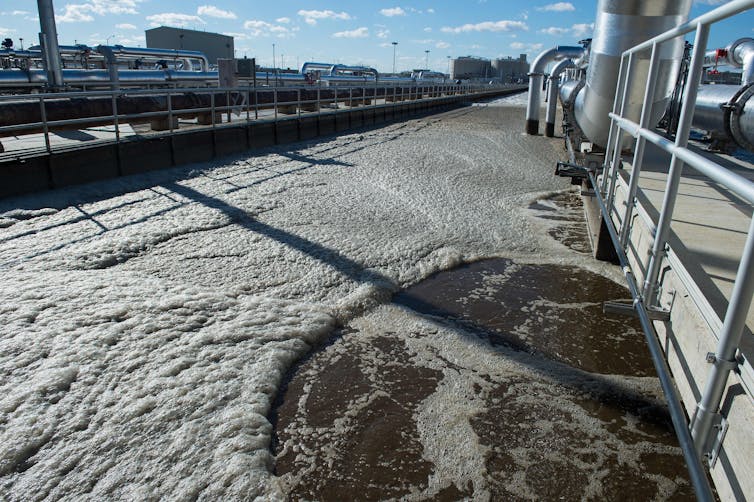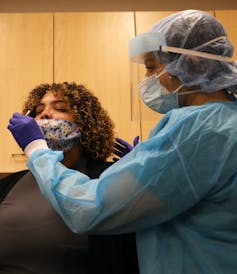COVID-19 clues in a community's sewage: 4 questions answered about watching wastewater for coronavirus
- Written by Kyle Bibby, Associate Professor of Environmental Engineering, University of Notre Dame
Researchers around the world are testing wastewater for the SARS-CoV-2 virus, in hopes that what goes down the drain can act as an early warning system for COVID-19 infections in communities.
Environmental engineer Kyle Bibby[1] is coordinating a nationwide research network sponsored by the National Science Foundation that aims to help scientists pool their work in this area. Here he explains the sewage-virus connection and how researchers hope to eventually translate raw measurements into useful public health information.
How do you monitor wastewater for germs?
This idea has gotten a lot of attention recently, but it’s not new. Scientists have been searching sewage for pathogens since at least the 1940s[2], most notably for poliovirus[3].
The overall concept is pretty straightforward. Infected individuals excrete the pathogen, which gets flushed down the toilet or washed down the drain. The pathogen – or fragments of its genes – then travel through a community’s sewage system to a treatment plant, where careful sampling can detect its presence.
About two-thirds of people infected with SARS-CoV-2 excrete the coronavirus in their stool[4]. A treatment facility can monitor wastewater for the virus’ RNA using molecular tools.
There’s no real standard yet, but most approaches involve concentrating the wastewater sample to some degree to make it more likely that you’ll be able to detect any RNA. We’re not looking for a whole, intact genome, but a small sequence of a single SARS-CoV-2 gene.
The RNA fragments that we’re measuring are too small to physically capture directly. So we use other tricks to snag them, usually by what we call electrostatic interaction – getting the RNA to stick to something like a filter, or using other chemicals to get it to clump together.
Then we quantify how much of the viral RNA is in the sample.
It’s important to recognize that we can’t directly extrapolate from what’s measured in the wastewater to how many people in the community have the coronavirus – at least not yet.
 Millions of households’ wastewater can flow to one treatment plant.
Nicholas Kamm/AFP via Getty Images[5]
Millions of households’ wastewater can flow to one treatment plant.
Nicholas Kamm/AFP via Getty Images[5]
What does the presence of coronavirus tell you?
We can have three related goals when we’re looking for viral RNA in the wastewater. First is direct surveillance. Essentially is the virus there, yes or no. That probably has the most promise within small confined communities, schools, dorms, prisons, long-term care facilities and so on. This would require sampling directly from the sewer at the facility. For instance, the University of Arizona detected the presence of asymptomatic infected students[6] by testing wastewater from on-campus housing.
The next potential application could be monitoring for trends. Is the apparent concentration of the virus increasing? That may indicate that infections within the community are increasing as well.
And the third application – which we’re probably the furthest away from – is directly applying our measurements to estimate the number of infected individuals in the community.
There’s a lot of uncertainty associated with how much of this virus an infected individual excretes, and how long they excrete it for – reports seem to suggest that it varies a lot. You could have one person sick with COVID-19 excreting 100 copies of the coronavirus genome per gram of feces. Another individual could be excreting 100 million copies per gram of feces, a big difference.
The overall vision is that wastewater monitoring could inform all sorts of public health intervention and disease surveillance programs. It could complement clinical surveillance, which often lags behind the true disease level in the community.
Is the wastewater itself a contamination risk?
Wastewater surveillance has typically been used to detect a pathogen that spreads via the fecal-oral route – not the respiratory route apparently responsible for SARS-CoV-2 infections. There’s debate about whether or not the coronavirus can be spread via water[7]. I would say it’s plausible, though it certainly isn’t a dominant transmission route and it hasn’t been demonstrated yet.
While there are some reports of infectious virus being excreted in stool, the vast majority appears to be inactivated[8] once it leaves a patient’s body. So I really don’t believe coronavirus in wastewater should be a significant concern for the general public.
It’s possibly a bigger concern to a wastewater worker. But the consensus is that standard personal protective equipment for dealing with wastewater is adequate for controlling the coronavirus. Remember – outside of the pandemic, wastewater can contain other infectious pathogens at any time.
 Researchers believe treated wastewater is not a coronavirus threat.
Jerry Holt/Star Tribune via Getty Images[9]
Researchers believe treated wastewater is not a coronavirus threat.
Jerry Holt/Star Tribune via Getty Images[9]
But imagine swimming at a beach downstream of a treatment plant. You don’t really need to worry about any bits of broken up viral genome left in the water. The concern is infectious virus and we just haven’t seen any infectious virus make it all the way to a sewage treatment plant, much less through the wastewater treatment and disinfection process.
What are the challenges to be worked out?
It’s a misconception to think this technique is ready to go right off the shelf. There’s still a lot of unsettled science about how to do it well.
 Wastewater screening serves a different purpose than testing individuals for SARS-CoV-2.
Spencer Platt/Getty Images North America via Getty Images[10]
Wastewater screening serves a different purpose than testing individuals for SARS-CoV-2.
Spencer Platt/Getty Images North America via Getty Images[10]
It’s also not quite right to think of this as like testing every single person in the community for COVID-19. There are a variety of issues with detection limits, getting composite samples that grab wastewater from throughout the day, and of course just the fact that many sick people might not excrete viral RNA for us to detect. A negative wastewater result does not in fact mean that zero people in the area have the coronavirus. So wastewater surveillance is subtly different from a clinical diagnosis tool.
I worry about a city’s department of health getting wastewater data from a contract lab and all of a sudden either thinking everything is safe and the coronavirus cases are low in their area or else overextrapolating that cases are high. It’s not like we couldn’t get to the ability to use this tool in this way pretty quickly. We’re just not there yet today.
My colleagues and I are trying to help establish a framework to translate this information to a usable format for communities, so municipalities can use wastewater monitoring to help make tough decisions that affect people’s lives and the economy. We also have projects looking at the persistence of this infectious virus in wastewater.
References
- ^ Environmental engineer Kyle Bibby (scholar.google.com)
- ^ since at least the 1940s (doi.org)
- ^ most notably for poliovirus (theconversation.com)
- ^ excrete the coronavirus in their stool (www.nature.com)
- ^ Nicholas Kamm/AFP via Getty Images (www.gettyimages.com)
- ^ detected the presence of asymptomatic infected students (tucson.com)
- ^ whether or not the coronavirus can be spread via water (doi.org)
- ^ majority appears to be inactivated (doi.org)
- ^ Jerry Holt/Star Tribune via Getty Images (www.gettyimages.com)
- ^ Spencer Platt/Getty Images North America via Getty Images (www.gettyimages.com)
Authors: Kyle Bibby, Associate Professor of Environmental Engineering, University of Notre Dame

